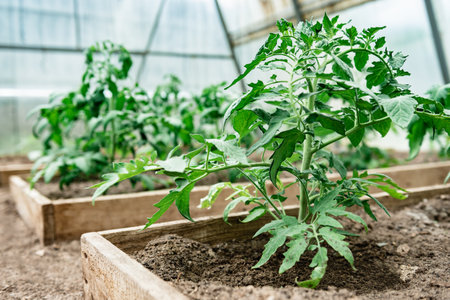Introduction to Heat Retention in UK Greenhouses
Greenhouse gardening is a cherished practice across the UK, offering a practical solution for extending growing seasons and nurturing tender crops. However, the British climate—marked by its cool temperatures, frequent rainfall, and unpredictable weather—poses ongoing challenges for gardeners aiming to cultivate healthy plants all year round. In this context, heat retention becomes essential. Effective insulation is the cornerstone of greenhouse success, helping to maintain stable temperatures and protect delicate plants from harsh cold snaps. Whether you are growing vegetables through winter or starting seedlings early in spring, maximising insulation ensures your efforts are not thwarted by the whims of the UK weather. This article explores both passive and active methods of heat retention, providing practical guidance tailored to British conditions so you can make the most of your greenhouse whatever the season.
2. Understanding Passive Heat Retention Methods
When it comes to maximising insulation in UK greenhouses, passive heat retention methods are both practical and cost-effective. These strategies focus on preventing heat loss rather than generating additional warmth, making them perfect for the British climate, where cold spells and fluctuating temperatures can challenge even the most robust greenhouse setups.
Double Glazing
One of the most effective ways to passively retain heat is through double glazing. This technique involves using two layers of glass or polycarbonate with a small air gap between them. The trapped air acts as an insulating barrier, reducing heat loss significantly compared to single-pane glazing. For UK gardeners, upgrading to double glazing means less reliance on electric heaters and better protection against frost, especially during unpredictable spring and autumn nights.
Thermal Screens
Thermal screens are another simple yet highly efficient passive insulation solution. These retractable or fixed covers are typically made from reflective or insulating materials. At night or during particularly cold days, drawing thermal screens over your greenhouse beds helps trap warm air inside while reflecting heat back towards your plants. In the UK’s often cloudy and chilly weather, thermal screens can make a substantial difference in maintaining consistent internal temperatures.
Strategic Positioning
The position of your greenhouse plays a crucial role in passive heat retention. Ideally, place your greenhouse along an east-west axis to capture maximum sunlight throughout the day. Locating it near a south-facing wall not only shelters it from harsh northerly winds but also allows the wall to act as a heat sink, absorbing daytime warmth and releasing it slowly overnight. This approach is particularly beneficial in Britain, where sunlight hours can be limited during winter months.
Comparison Table: Passive Insulation Techniques for UK Greenhouses
| Technique | Main Benefit | Suitability for UK Climate | Ease of Implementation |
|---|---|---|---|
| Double Glazing | Reduces heat loss; protects against frost | Highly suitable (prevents rapid temperature drops) | Moderate (requires installation or upgrade) |
| Thermal Screens | Keeps warmth in at night; lowers heating costs | Very suitable (works well with variable weather) | Easy (can be retrofitted) |
| Strategic Positioning | Maximises sun exposure; utilises existing structures for warmth | Ideal (optimises natural resources) | Simple (considered at planning stage) |
Conclusion on Passive Methods
The combination of double glazing, thermal screens, and thoughtful positioning offers British gardeners a robust foundation for passive greenhouse insulation. By tailoring these approaches to local conditions, you can create a more stable growing environment that supports healthy plants year-round—without excessive energy bills or complex systems.

3. Active Heat Retention Techniques
When passive methods alone aren’t enough to keep your greenhouse warm through the UK’s unpredictable weather, active heat retention techniques come into play. These systems generate and distribute additional heat, ensuring that sensitive plants survive even the coldest nights. Here’s a closer look at some of the most popular active heating options for UK greenhouses.
Electric Heaters
Electric heaters are a common choice in Britain due to their convenience and control. Many models offer thermostats and timers, allowing you to maintain a steady temperature without constant supervision. They are clean, efficient, and easy to install—ideal for both small hobbyist spaces and larger growing environments. However, running costs can be significant, especially during long cold spells, so it’s wise to pair them with good insulation and only use them when absolutely necessary.
Heated Propagators
For gardeners focusing on seed starting or keeping young plants warm, heated propagators provide targeted warmth directly at root level. These compact units use minimal electricity and are perfect for propagating delicate crops like tomatoes or early salads. By using heated propagators inside an insulated greenhouse, you can extend your growing season while keeping energy use efficient and focused.
Paraffin Heaters
Paraffin (kerosene) heaters have been a traditional option in the UK for decades. They are reliable during power cuts and don’t require mains electricity, making them practical for remote allotments or sheds. While they do emit moisture and carbon dioxide—which can benefit some plants—they also require good ventilation to prevent condensation and sooty residues. Paraffin heaters remain an affordable solution for those looking to provide gentle background warmth without a big upfront investment.
Choosing the Right System
The best active heating method depends on your greenhouse size, insulation quality, and what you’re growing. For many British gardeners, combining a small electric heater with passive techniques strikes a balance between comfort and cost. Always prioritise safety—keep heaters clear of flammable materials and ensure proper ventilation.
Energy Efficiency Tips
To make any heating system more efficient, regularly check seals around doors and vents, invest in thermal screens or bubble wrap lining, and monitor temperatures with a reliable thermometer. This way, you’ll keep running costs down while maximising plant protection throughout the UK’s chilly months.
4. Choosing Insulation Materials for British Greenhouses
When selecting insulation materials for greenhouses in the UK, its essential to strike a balance between cost, effectiveness, and ease of installation. British weather presents unique challenges: fluctuating temperatures, frequent rain, and occasional frost. Fortunately, several affordable and accessible products are well-suited to these conditions. Below is a review of popular insulation options available across the UK.
Common Greenhouse Insulation Materials
| Material | Main Benefits | Considerations | Typical Cost |
|---|---|---|---|
| Bubble Wrap | Excellent thermal retention; easy to fit to existing glazing; reusable year after year | Reduces light slightly; best replaced every few seasons for maximum efficiency | Low – widely available at garden centres and DIY stores |
| Fleece | Lightweight; provides gentle frost protection for plants; breathable fabric prevents mould growth | Mainly for covering plants rather than glazing; may need regular repositioning after storms | Very low – sold by the metre or in rolls at most UK retailers |
| Horticultural Glass (Double Glazing) | Strong insulation; maximises natural light entry; durable and long-lasting | Higher upfront investment; heavier and requires professional fitting for retrofits | High – but can pay off in energy savings over time |
| Thermal Screens/Insulating Curtains | Adds an extra barrier at night; retractable for daytime sunlight; reduces heat loss significantly | May require track installation; initial outlay higher than fleece or bubble wrap | Medium – becoming more common in UK garden suppliers |
Making the Right Choice for Your Greenhouse
The best insulation material often depends on your greenhouse type, plant selection, and budget. For many British gardeners, a combination approach works well: using bubble wrap on glazing panels during winter months and fleece to shield vulnerable crops from cold snaps. For those investing in new structures or significant upgrades, double-glazed horticultural glass offers superior performance but comes at a premium price.
Tips for Effective Installation:
- Bubbles Facing Outwards: When installing bubble wrap, ensure the bubbles face outwards to trap air against the glass.
- Avoid Draughts: Seal gaps around doors, vents, and windows with foam tape or weatherstripping.
- Layer Wisely: Combine materials where possible—such as fleece inside a bubble-wrapped frame—to maximise protection.
- Regular Checks: Inspect insulation after storms or heavy rainfall to ensure it remains securely fixed.
Sourcing Insulation Materials Locally
B&Q, Homebase, Wickes, and local garden centres all stock suitable insulation materials year-round. For eco-conscious gardeners, consider reusing packaging-grade bubble wrap or sourcing recycled horticultural glass panels. By choosing the right materials and fitting them properly, UK gardeners can create a warmer, more energy-efficient greenhouse that supports healthy plant growth throughout the unpredictable British seasons.
5. Reducing Heat Loss Through Smart Maintenance
Smart maintenance is key to keeping your UK greenhouse warm and energy-efficient throughout the colder months. By focusing on sealing draughts, performing regular checks, and ensuring airtightness, you can greatly minimise unnecessary heat loss.
Seal Draughts Effectively
Even the smallest gaps around doors, windows, or panels can let in cold air and allow valuable warmth to escape. Use weatherproof tapes or rubber seals specifically designed for greenhouses to block these draughts. Pay special attention to sliding doors and ventilation windows, as these areas are most prone to developing gaps over time.
Regular Greenhouse Checks
Make it a habit to inspect your greenhouse at least once a month, especially before winter sets in. Look for cracked glass, loose panes, or worn-out seals that might be letting cold air seep inside. Early detection and prompt repairs help maintain steady internal temperatures and prevent costly heat loss.
Maintain Airtightness
Airtightness is crucial for maximising insulation. Ensure that all panels fit snugly within their frames and replace any broken or missing glazing clips promptly. For older greenhouses, consider adding an extra layer of bubble wrap insulation or horticultural fleece along the interior walls to further reduce heat escape without compromising light levels.
Practical Tip
On a windy day, run your hand around the inside edges of your greenhouse to feel for draughts—this simple test can quickly identify problem spots needing attention.
By keeping up with these straightforward maintenance tasks, you’ll not only retain more heat passively but also ensure that any active heating systems work more efficiently—helping both your plants and your energy bills thrive during the British winter.
6. Balancing Insulation with Ventilation Needs
While maximising insulation is essential for heat retention in UK greenhouses, achieving the right balance with ventilation is equally important for plant health. Over-insulating a greenhouse can trap excessive moisture and stale air, leading to mould, fungal diseases, and poor growth. Therefore, effective greenhouse management involves finding a middle ground where warmth is preserved without compromising air quality.
Why Ventilation Matters
Fresh air circulation helps regulate humidity and prevents the build-up of pathogens. In the UK’s typically damp climate, stagnant air can quickly become a problem. Regular ventilation introduces oxygen and reduces condensation, supporting robust root systems and healthy foliage.
Passive Ventilation Techniques
Simple solutions such as opening roof vents or louvres during the day allow for natural airflow while still maintaining much of the retained heat. Installing automatic vent openers can help balance temperature and humidity without constant supervision. Even partially opening doors or windows on milder days will refresh your greenhouse environment.
Active Ventilation Solutions
For those using active heat retention methods like electric heaters or thermal fans, consider pairing them with extractor fans or circulators. These devices distribute warm air evenly and prevent cold spots while still allowing for controlled air exchange. Timed or thermostatically controlled systems are especially useful in larger or more intensively used greenhouses.
Practical Tips for UK Growers
On frosty nights, keep insulation layers (such as bubble wrap) in place but crack a window slightly to prevent condensation. Monitor both temperature and humidity with reliable gauges. If daytime temperatures rise above 20°C, prioritise ventilation to avoid overheating—even in winter. Remember, fluctuating between warmth at night and fresh air by day creates an environment where plants thrive without unnecessary energy loss.
By thoughtfully combining both passive and active heat retention methods with sensible ventilation routines, you can create a stable microclimate that supports healthy plant development throughout the UK’s varied seasons.
7. Seasonal Strategies for Greenhouse Heat Management
Adapting your greenhouse insulation and heating methods to suit the British seasons is key for healthy, productive plants all year round. As autumn approaches, temperatures drop and daylight shortens, so it’s wise to check your greenhouse for draughts and reinforce passive insulation with bubble wrap or thermal screens. Consider installing thermal curtains that can be drawn at night to trap daytime warmth. During the colder winter months, combine these passive measures with active solutions such as electric or gas heaters set on thermostats, ensuring a steady minimum temperature is maintained without wasting energy. For UK growers, remember to place water barrels inside the greenhouse; they absorb heat during sunny spells and release it slowly overnight. As spring arrives and temperatures start to climb, ventilation becomes crucial. Gradually reduce insulation layers, open vents during warmer days, and monitor humidity to prevent fungal issues. Automatic vent openers are a practical investment for changeable British weather. Throughout each season, regularly check seals and repair any damage caused by storms or frost. By tailoring your insulation and heating approach to the UK’s unpredictable climate, you’ll extend your growing season and protect both tender seedlings and mature crops.


